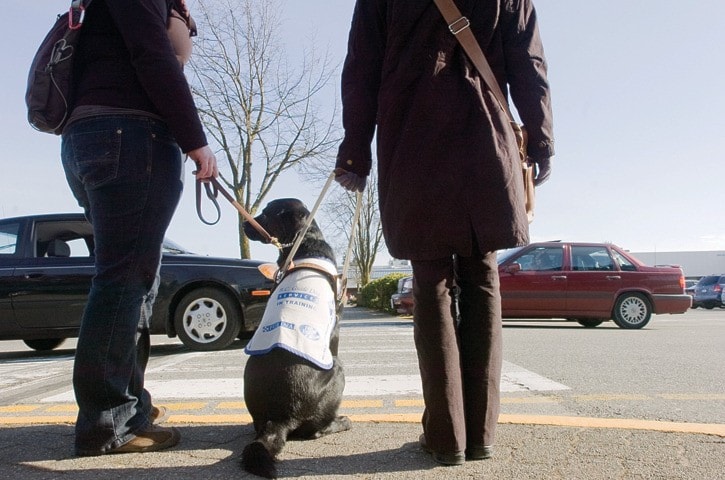Amidst the blare of traffic and passing of pedestrians, Neptune is focused.
The black Lab/golden retriever cross navigates a safe path down the sidewalk, taking care to walk in a straight line before sitting at the curb and awaiting instructions from the blindfolded volunteer clutching the harness on Neptune’s back.
Upon hearing the command “forward,” he is off again at a steady pace, his tail wagging in the morning air.
After successfully leading the volunteer around the back parking lot of Semiahmoo Shopping Centre this week, guide dog mobility instructor Jaime Arnup makes sure to give Neptune the praise he has earned.
And while he excitedly laps up the scratches and pats as any pooch would, he isn’t just any dog. The two-year-old is on his last day of training with B.C. Guide Dog Services, and is to be placed with his visually impaired owner the following morning. He has been qualified as a guide following five months of advanced training held across the Lower Mainland.
Arnup said South Surrey’s uptown area is ideal for training beginner dogs because of its quiet residential areas and easy-to-navigate grid layout.
Dogs in training start off in such calm environments before working their way up to more chaotic settings, the ultimate being Downtown Vancouver.
B.C. Guide Dog Services breeds its own dogs, which stay with volunteers during their first seven to eight weeks of life. They then spend the next eight weeks with puppy-raising families – volunteers who socialize the dogs and teach them basic obedience.
“We take that obedience and use it to teach them to guide,” Arnup said.
Dogs are placed in boarding homes during advanced training, when dogs learn to walk in a straight line until the environment or direction changes.
The dogs are taught to identify obstructions by practising on artificial obstacle courses at the service’s Ladner training centre. They also learn to read foot positions, hand signals and verbal instructions, such as the “find” command, which tells them to locate objects and places such as doors, benches, elevator buttons, escalators or stairs.
“They learn through repetition,” Arnup said. “Dogs are creatures of habit.”
Once ready to start their careers, they are placed with owners based on compatibility.
Guide dog mobility instructors (GDMIs) spend a few weeks with dog and client to ensure a smooth transfer of ownership. Arnup said retrievers and labs easily adapt to new homes, which is why the breeds are commonly used for guide-dog training.
It tends to take about a year for a strong bond to form between dog and owner, Arnup said, and once that connection has taken root, it’s hard to break. She said dogs take accountability for their owners and don’t like being separated from them.
While they enjoy the work, Arnup said it is mandatory that guides end their careers at age 10.
“We feel the dogs have done their duty at that point and they deserve a healthy retirement.”
Owners are encouraged to keep their dogs, and it is not uncommon for a client to have both a retired guide dog and a newly placed one, she noted.
Arnup, who spends five days a week with dogs during their five-month advanced training, said she’s not sad to pass her graduates onto clients.
“Once I’ve trained them and picked their owner, I’m more proud than anything.”
What is more difficult, she said, is when a dog is disqualified from becoming a guide due to a bad habit, such as stealing food or being easily distracted by other animals.
However, since sister charity Autism Support Dogs launched in 2008, B.C. Guide Dog Services has been placing dogs who aren’t eligible to be guides (about 40 to 50 per cent don’t meet requirements) with autistic children who have different needs.
Arnup said dogs who are more suitable for the autism program tend to be patient, tolerant and have lower energy drives.
“It’s a perfect fit because the dogs we were having issues with previously were perfect for this.”
Having a place for such dogs has boosted B.C. Guide Dog Service’s productivity. The organization experienced its highest placement percentage last year, placing 20 dogs in total; seven with the autism program and 13 as guides. Since its inception in 1996, the charity has placed 94 dogs – at a cost of $37,000 each – and hopes to reach 100 by summer.
When seeing the dogs at work, Arnup encourages the public to follow proper etiquette, which includes refraining from petting, feeding or distracting them in any way.
While the dogs can often serve as a “social icebreaker” for visually impaired people, Arnup said owners are often on their way somewhere, and being constantly stopped by people curious about their dogs is in some ways like one’s car continually stalling on the way to work.
“Their guide dog is their vehicle to get to work, and they need it to function.”
For more information about B.C. Guide Dog Services – as well as volunteer and sponsorship opportunities – visit bcguidedog.com
